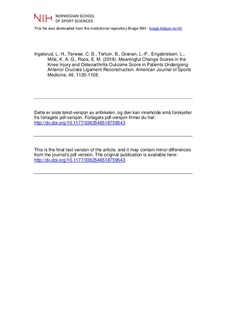| dc.contributor.author | Ingelsrud, Lina H. | |
| dc.contributor.author | Terwee, Caroline B. | |
| dc.contributor.author | Terluin, Berend | |
| dc.contributor.author | Granan, Lars-Petter | |
| dc.contributor.author | Engebretsen, Lars | |
| dc.contributor.author | Mills, Kathryn A.G. | |
| dc.contributor.author | Roos, Ewa M. | |
| dc.date.accessioned | 2019-04-29T07:48:46Z | |
| dc.date.available | 2019-04-29T07:48:46Z | |
| dc.date.created | 2018-07-16T13:28:56Z | |
| dc.date.issued | 2018 | |
| dc.identifier.citation | American Journal of Sports Medicine. 2018, 46, 1120-1128. | nb_NO |
| dc.identifier.issn | 0363-5465 | |
| dc.identifier.uri | http://hdl.handle.net/11250/2595835 | |
| dc.description | I Brage finner du siste tekst-versjon av artikkelen, og den kan inneholde ubetydelige forskjeller fra forlagets pdf-versjon. Forlagets pdf-versjon finner du på sagepub.com: http://doi.org/10.1177/0363546518759543 / In Brage you'll find the final text version of the article, and it may contain insignificant differences from the journal's pdf version. The definitive version is available at sagepub.com: http://doi.org/10.1177/0363546518759543 | nb_NO |
| dc.description.abstract | Background: Meaningful change scores in the Knee injury and Osteoarthritis Outcome Score (KOOS) in patients undergoing anterior cruciate ligament (ACL) reconstruction have not yet been established. Purpose: To define the minimal important change (MIC) for the KOOS after ACL reconstruction. Study Design: Cohort study (diagnosis); Level of evidence, 2. Methods: KOOS and anchor questions with 7-point scales ranging from “better, an important improvement” to “worse, an important worsening” were completed postoperatively by randomly chosen participants from the Norwegian Knee Ligament Registry. Presurgery KOOS scores were retrieved from the registry. The MIC for improvement was calculated with anchor-based approaches using the predictive modeling method adjusted for the proportion of improved patients, the mean change method, and the receiver operating characteristic (ROC) method. Results: Complete data for at least one of the KOOS subscales were obtained from 542 (45.3%) participants. Predictive modeling MIC values were 12.1 for the KOOS subscales of Sport and Recreational Function and 18.3 for Knee-Related Quality of Life. These values aid in interpreting within-group improvement over time and can be used as responder criteria when comparing groups. The corresponding and much lower values for the subscales of Pain (2.5), Symptoms (–1.2), and Activities of Daily Living (2.4) are the results from patients reporting, on average, only mild problems with these domains preoperatively. Although 4% to 10% of patients reported subscale-specific worsening, MIC deterioration calculations were not possible. The ROC MIC values were associated with high degrees of misclassification. Values obtained by the mean change method were considered less reliable because these estimates are derived from subgroups of patients. Average KOOS change scores were approximately similar for patients reporting acceptable symptoms postoperatively and patients reporting important improvements on the anchor items after surgery. Conclusion: KOOS users should apply subscale-specific cutoffs for meaningful improvement. Our results confirm using the subscales of Sport and Recreational Function and Knee-Related Quality of Life as primary patient-reported outcomes after ACL reconstruction. The predictive modeling approach gave the most robust estimates of MIC values. Our data suggest that reporting acceptable symptoms postoperatively corresponds to reporting an important improvement after ACL reconstruction. | nb_NO |
| dc.language.iso | eng | nb_NO |
| dc.subject | minimal important change | nb_NO |
| dc.subject | knee injury and osteoarthritis outcome score | nb_NO |
| dc.subject | anterior cruciate ligament reconstruction | nb_NO |
| dc.title | Meaningful Change Scores in the Knee Injury and Osteoarthritis Outcome Score in Patients Undergoing Anterior Cruciate Ligament Reconstruction | nb_NO |
| dc.type | Journal article | nb_NO |
| dc.type | Peer reviewed | nb_NO |
| dc.description.version | acceptedVersion | nb_NO |
| dc.source.pagenumber | 1120-1128 | nb_NO |
| dc.source.volume | 46 | nb_NO |
| dc.source.journal | American Journal of Sports Medicine | nb_NO |
| dc.source.issue | 5 | nb_NO |
| dc.identifier.doi | 10.1177/0363546518759543 | |
| dc.identifier.cristin | 1597466 | |
| dc.description.localcode | Seksjon for idrettsmedisinske fag / Department of Sport Medicine | nb_NO |
| cristin.unitcode | 150,34,0,0 | |
| cristin.unitname | Seksjon for idrettsmedisinske fag | |
| cristin.ispublished | true | |
| cristin.fulltext | postprint | |
| cristin.qualitycode | 2 | |
